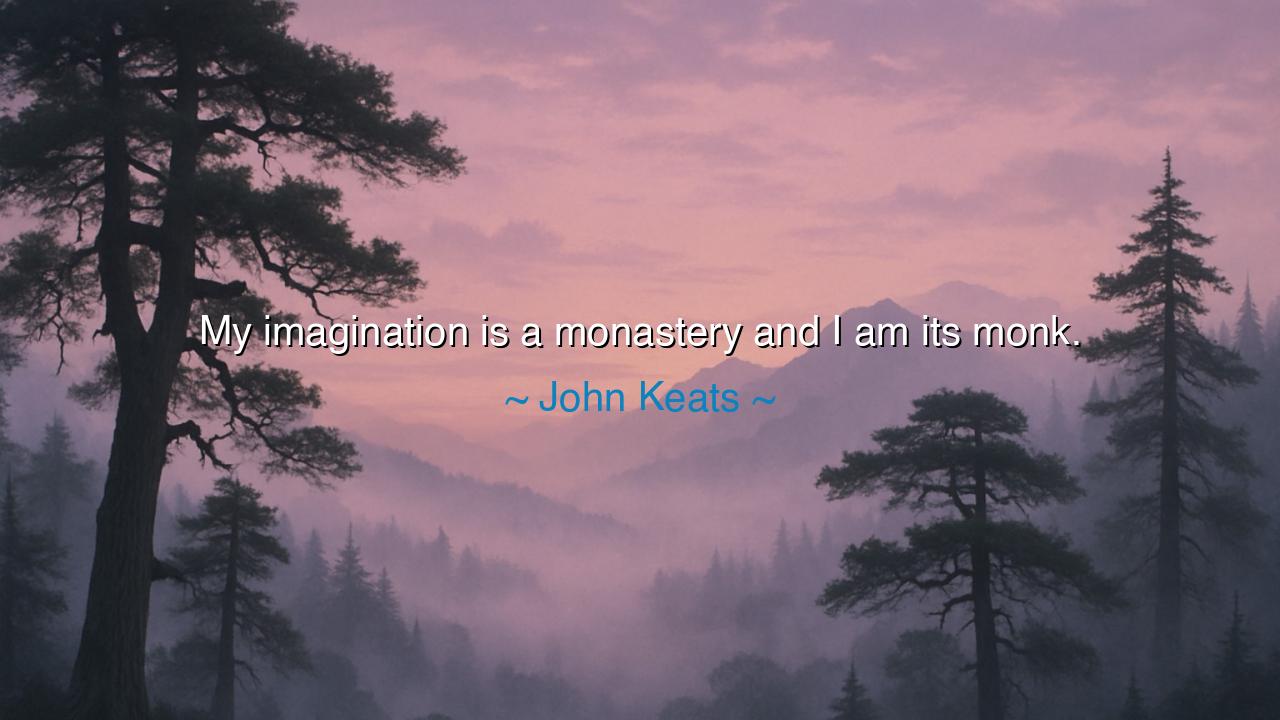
My imagination is a monastery and I am its monk.






The Sacred Cell of the Mind: The Discipline of the Imagination
Hear now, O listener of wisdom and wanderer of thought, the words of John Keats, the poet of beauty and melancholy: “My imagination is a monastery and I am its monk.” These words, soft as a whisper and yet vast as eternity, are not merely the reflections of an artist — they are the confession of a soul that found in imagination both its sanctuary and its solitude. For Keats knew that to dream deeply is not to escape the world, but to consecrate oneself to its mysteries, to dwell in the silent cloisters of the mind where the spirit communes with creation.
When Keats spoke these words, he was still young, but already burdened by frailty and aware of his mortal limits. His body was weak, but his imagination was infinite. In his poems, he sought refuge not in marble cathedrals or courts of kings, but in the inward monastery of his own making — a temple of vision and wonder, where thoughts became prayers and beauty became the divine. The monk, after all, is one who renounces the noise of the world to seek truth in contemplation. So too did Keats, withdrawing from worldly ambition to dwell in the sacred solitude of his art.
This image — of the poet as monk and imagination as monastery — is as ancient as creation itself. The philosopher Plotinus spoke of the soul’s ascent inward, toward the realm of the ideal and eternal. The mystics of every age — from the desert fathers to the sages of the East — have taught that the deepest revelations are not found in noise or conquest, but in silence and inward devotion. Keats, though a man of verse rather than theology, walked the same path. For him, imagination was not a mere tool for invention; it was a holy practice — the means by which the mortal glimpses the immortal.
Yet Keats’s monastery was no cold or austere retreat. It was a place alive with beauty and light — a garden enclosed within the soul, where sensations became hymns and emotions, sacred incense. Within this monastery, he wrote of Grecian urns that sang of eternity, of nightingales whose songs echoed beyond death, of lovers frozen forever in the perfection of art. Each vision was a kind of prayer, each poem a meditation. In this way, he lived as a monk of imagination, devoted not to denial, but to wonder — not to the absence of the world, but to its spiritual essence.
Consider the story of Leonardo da Vinci, another monk of imagination. Though not bound by vows, he too lived in devotion — to art, to curiosity, to the mysterious unity of all things. His solitude was his monastery, his sketchbook his sacred scripture. Like Keats, he found holiness in creation itself. Such souls show us that to live imaginatively is to live with reverence — to treat thought, vision, and beauty as sacred things. The monastery of the mind is open to all who dare to enter, but few are willing to endure the discipline it requires: patience, silence, humility before the unknown.
For Keats’s metaphor carries not only wonder, but warning. The imagination, left unguarded, can wander into chaos or despair. The monk’s role is not only to dream, but to discipline his dreaming — to tend it as a gardener tends a sacred grove. In this, Keats teaches us that creativity requires devotion. One must cultivate the imagination, restrain its impulses, and guide it toward truth and beauty. To dwell in the monastery of the mind is to dedicate oneself daily to the work of the spirit, to find meaning not in noise but in quiet persistence.
So, what lesson does this holy image offer us? It is this: guard your imagination as a sacred space. Do not let it be corrupted by distraction or despair. Retreat into it as the monk retreats into prayer — not to flee the world, but to see it more clearly. Nurture it with art, with silence, with reflection. Let your thoughts become meditations, your visions become acts of creation. For in doing so, you will find what Keats found: that even in solitude, the spirit is never alone, and that the imagination, when sanctified by purpose, becomes a bridge to the divine.
Thus, remember the poet’s creed: “My imagination is a monastery and I am its monk.” Within your mind lies a temple waiting to be entered. Within your soul, a lamp waiting to be lit. Enter often, and in stillness, create your miracles. For there, in the quiet chambers of thought and beauty, the infinite waits to speak — and the monk of the imagination listens.






AAdministratorAdministrator
Welcome, honored guests. Please leave a comment, we will respond soon